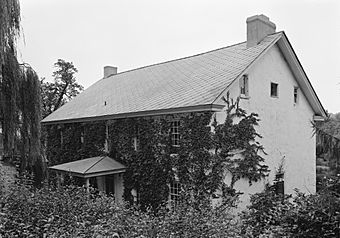Charlestown Village Historic District facts for kids
The Charlestown Village Historic District is a very special area in Charlestown Township, Pennsylvania. It's like a living museum! This district protects many old buildings and structures. They show us what life was like from the 1740s to the 1870s. It's a great example of how people lived and built things long ago.
Contents
Discover Charlestown Village
Charlestown Village is a small, historic community. It is found in Chester County, Pennsylvania. This area is next to another historic spot, the Middle Pickering Rural Historic District. The district covers about 126 acres. It includes 21 important buildings and one structure. These buildings are all part of the village's history.
A Glimpse into the Past
The buildings in Charlestown Village show different styles of architecture. These styles were popular between 1740 and 1870. You can see examples of Late Victorian and Italianate designs. Each building tells a part of the village's story.
Important Buildings to Explore
Many buildings in the district are very old and interesting. They include homes, a mill, and a church.
The Job Harvey House
The oldest building in the district is the Job Harvey House. It was built around 1740. Imagine how many people have lived there over the centuries! It's a true piece of history.
The Old Mill and Church
Other notable buildings include the Charlestown Woolen Mill. This mill was built between 1862 and 1865. There's also the Charlestown Methodist Episcopal Church. It was built in 1840 and updated in 1881. You can also find the William Nixon House (around 1817), the Moses King House, and the William Howard house. The "Town Hall" is also part of this historic area.
Why is it a Historic District?
A historic district is a special area. It's recognized for its important history and architecture. The Charlestown Village Historic District was added to the National Register of Historic Places in 1978. This means it's officially protected. It's a place where we can learn about the past and see how communities grew.




